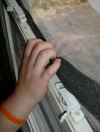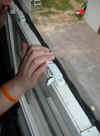Living with Urban Wildlife
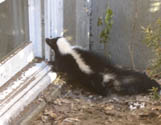 In many areas of the country wild animals have had their habitat taken from them and are now forced to live in urban areas. The woodlots that these animals used to call home have been replaced by subdivisions and strip-malls. Animals such as bats, squirrels, raccoons and even skunks now live and thrive in urban environments.
In many areas of the country wild animals have had their habitat taken from them and are now forced to live in urban areas. The woodlots that these animals used to call home have been replaced by subdivisions and strip-malls. Animals such as bats, squirrels, raccoons and even skunks now live and thrive in urban environments.
A raccoon that used to live in a hollow tree by a river now lives in the chimney of a 3-bedroom ranch.
A bat that used to live in a rock formation on a hill now lives in the attic of a 2-story colonial house.
A skunk that used to live in a den at the base of an old pine tree now lives under a porch.
A squirrel that used to live in a nest at the top of an oak tree now lives in the attic of an apartment building.
In some situations humans and wild animals can peacefully co-exist. However, conflicts between humans and wildlife occur when these animals go in search of food or shelter on your property. Listed below are the most common nuisance animals along with solutions that you can use to prevent problems with these animals.
Raccoons
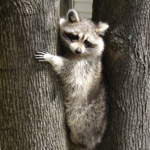
The most common complaint that arises from these masked bandits is that of raccoons knocking over trash barrels. You have to understand that trash night is a very big event for the neighborhood raccoon. An un-secured trash barrel to them is like a free trip to the steak-house to us. Line the streets with them and its easy to see why they are so persistent when it comes to knocking over your trash barrels.
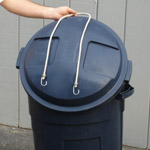
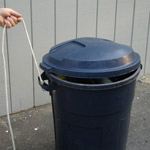
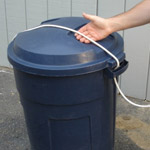
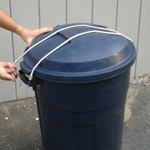
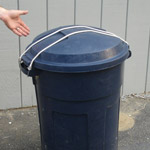
The Solution
Secure your trash barrels. Now, this seems simple enough but raccoons are very intelligent animals. A simple rock placed on the lid of the barrel is not going to work. They'll simply knock over the barrel sending the rock flying, tear the lid off and tear apart the garbage. A bungee-cord system is much more effective at keeping raccoons out of your trash. Attach the bungee-cord to the handle of the barrel as shown in the picture below. Run the cord over the lid, through the handle on the opposite side and hook back on the first handle. This will provide enough downward pressure so that even if they do tip over the barrel they will not be able to remove the lid. Do this to all your barrels and you'll be free of trash-stealing bandits.
Bats
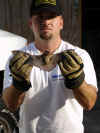 In the heat of the summer is when bats will show up the most. When the attics they call home get too hot for them they will drop down into the living space of houses in search of cooler areas. This usually happens during the night when people are sleeping or getting ready for bed. The sudden arrival of a bat in a living room at night can best be described as "chaotic". Some people will arm themselves with brooms and hockey helmets while others will seek refuge at the neighbor's house or even at a hotel for the night until help can arrive.
In the heat of the summer is when bats will show up the most. When the attics they call home get too hot for them they will drop down into the living space of houses in search of cooler areas. This usually happens during the night when people are sleeping or getting ready for bed. The sudden arrival of a bat in a living room at night can best be described as "chaotic". Some people will arm themselves with brooms and hockey helmets while others will seek refuge at the neighbor's house or even at a hotel for the night until help can arrive.
Do Not Touch
 We strongly recommend that homeowners not handle bats in any way. Bats have razor-sharp teeth and they will bite you if you pick them up. Bats are also a "target species" for carrying rabies in most parts of the country. If you do get a bat in your home we strongly suggest that you call a professional to remove the bat. However, there are steps you can take to prevent bats from taking up residence in your house and attic.
We strongly recommend that homeowners not handle bats in any way. Bats have razor-sharp teeth and they will bite you if you pick them up. Bats are also a "target species" for carrying rabies in most parts of the country. If you do get a bat in your home we strongly suggest that you call a professional to remove the bat. However, there are steps you can take to prevent bats from taking up residence in your house and attic.
The Chimney
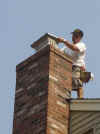 A common entry point that bats use to enter houses is the chimney. An uncapped chimney is an open door to bats as well as other animals. When a bat falls down a chimney flu it cannot get out and is trapped. Bats will usually squeeze their way past the damper and into the fireplace then into the living room. This can all be avoided by capping your chimney and also making sure that you damper is closed when the chimney is not in use.
A common entry point that bats use to enter houses is the chimney. An uncapped chimney is an open door to bats as well as other animals. When a bat falls down a chimney flu it cannot get out and is trapped. Bats will usually squeeze their way past the damper and into the fireplace then into the living room. This can all be avoided by capping your chimney and also making sure that you damper is closed when the chimney is not in use.
Air Conditioning Units
Bats will often enter homes through improperly installed air conditioning units. Bats can sense the air currents that flow through the gap between the glass panes in the window. Bats will land on the outside of the air conditioner and then crawl up between the panes of glass and drop into the house. I have been called out to homes on several occasions to remove bats from this area. This can be avoided by using the black foam strip that comes with every air conditioner and following the steps listed below to secure your window-mounted air conditioning units.
Click the images to enlarge them.
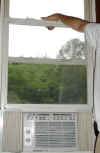 Pointing out the gap between windows.
Pointing out the gap between windows.
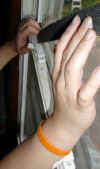 Stuff one end of the foam into the left side of the gap.
Stuff one end of the foam into the left side of the gap.
 Move left to right pushing the foam down into the gap as you go.
Move left to right pushing the foam down into the gap as you go.
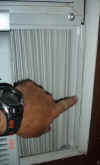 Make sure the adjustable wings of the unit are tight against the sides and the bottom of the window frame. Small screws can be used to keep these wings in place.
Make sure the adjustable wings of the unit are tight against the sides and the bottom of the window frame. Small screws can be used to keep these wings in place.
 Take these precautions and you will prevent an unexpected visit from this guy!
Take these precautions and you will prevent an unexpected visit from this guy!
Other preventive maintenance practices can keep bats out of your attic as well. Replacing rotted or defective attic vents and/or other areas of wood-rot or damage on your roof-line will keep bats from entering your home.
Skunks
 These critters get the award for being the most unpleasant animal in the suburbs. Most notably known for their strong smell, skunks face an extreme loss of habitat in suburban areas. When woodlots are developed, skunks are forced to live under decks, sheds and even houses. If these animals are left alone they pose very little threat or inconvenience to humans. It is when other animals threaten the skunk that they unleash the potent odor that a skunk is best known for. Skunks will often spray domestic animals when they feel threatened. This creates a big problem for the homeowner. Anyone that has ever had to bath a skunk-sprayed dog knows how unpleasant this experience can be.
These critters get the award for being the most unpleasant animal in the suburbs. Most notably known for their strong smell, skunks face an extreme loss of habitat in suburban areas. When woodlots are developed, skunks are forced to live under decks, sheds and even houses. If these animals are left alone they pose very little threat or inconvenience to humans. It is when other animals threaten the skunk that they unleash the potent odor that a skunk is best known for. Skunks will often spray domestic animals when they feel threatened. This creates a big problem for the homeowner. Anyone that has ever had to bath a skunk-sprayed dog knows how unpleasant this experience can be.
The Solution
There are several things homeowners can do to prevent skunk problems. If you have skunks in your yard it is best to try and figure out why they are there.
- Is there habitat for them? Is the skunk living under your shed? Your deck? If so they must be evicted and the shed must be skunk-proofed.
- Is there a food source for the skunks?
- Are the skunks attracted to your trash barrels? Are they eating grubs from you lawn? If so, a product called Grub-x can be applied to your lawn to kill the grubs and remove the food source.
Once you have eliminated the skunks' habitat and/or their food source they will leave the area.
Squirrels
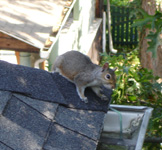
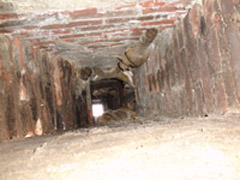
There are two common problems with squirrels in urban and suburban areas:
- Squirrels falling down chimneys
- Squirrels chewing their way into attics
For squirrels in attics there are two main methods of preventive maintenance that a homeowner can practice that will drastically reduce the chances of getting squirrels in your attic.
Trim back those tree branches! A squirrel cannot chew a hole into a roof if it cannot get on the roof in the first place. Keep all branches trimmed back at least 10 feet from the edge of your roof at all times. In some situations, squirrels can climb up the corners of houses or scurry across power lines, but they prefer to use tree branches. In these cases, trimming back the branches will at least make it more difficult for squirrels to get on your roof and will deter them from doing so.
Clean those gutters! Gutters collect acorns and other nuts and act as a feeding trough for squirrels and other rodents. A gutter that is full of leaves and nuts is like a welcome mat for squirrels. While they're up there they will chew a hole in your fascia board (board that the gutter is nailed to) and set up shop in your attic.
Keep those branches trimmed back and your gutters clean and you won't have to worry about squirrels in your attic. Keep up with the maintenance of your home and replace rotted or old attic vents and/or other areas of wood-rot of damage on your roof-line will keep squirrels from entering your home.
Enjoy Suburban Wildlife!
Even though wild animals in the suburbs can sometimes cause damage to homes and cause headaches for homeowners, they can also be very entertaining and enjoyable. Once your home is properly secured you can take measures to safely attract certain types of wildlife to your property:
- Bird feeders can be placed on decks and throughout the yard to attract different types of birds and squirrels.
- Bat houses can be built and installed in backyards to attract bats in the summer months. Building and installing a bat house is a great project for the whole family to get involved in. Bat Conservation International has a very useful page with answers to questions about bat houses.
Wild animals in the suburbs are here to stay. Take the necessary precautions to secure your property and then enjoy them. Teach your children about the crafty wild animals that live in your neighborhood and how they have adapted to their ever-changing habitat.
About the Author: Matthew Grady is the owner of BatGuys Wildlife Services, a wildlife removal company serving Massachusetts and Rhode Island. He is a member of Bat Conservation International, the National Wildlife Control Operators Association and the Massachusetts Association of Problem Animal Controllers. He and his company's technicians are fully licensed to perform animal control and wildlife removal in Massachusetts and Rhode Island.
If you would like to reproduce this article: Permission is granted provided that the article is reproduced in its entirety as shown above, with the resource box/bio included, linking to http://www.batguys.com as the original publisher and author's site. Please email us notification that you would like to use the article and where you intend to publish it.
